High Impact Tutoring Built By Math Experts
Personalized standards-aligned one-on-one math tutoring for schools and districts
In order to access this I need to be confident with:
Percent to decimal Fraction to percent Decimal to percent Exponential functionsExponential decay
Here you will learn about exponential decay, including what it is and how to solve problems involving exponential decay.
Students first learn about exponential decay in seventh grade math when they explore percent of increase and decrease. Students expand their knowledge as they work with exponential functions in Algebra 1 and Algebra 2.
What is exponential decay?
Exponential decay is the process of reducing an amount by a consistent percentage rate over a period of time.
Exponential decay, which is sometimes referred to as depreciation, can be modeled using the exponential decay model,
y=a(1-r)^x \;\; OR \;\; f(t)=a(a-r)^t
\begin{aligned}& a=\text { initial value } \\\\ & r=\text { rate } \\\\ & x=\text { amount of time } \end{aligned}Notice how in the parenthesis the rate is being subtracted from 1. When a number is multiplied to a decimal less than 1 , the product is less than the initial value.
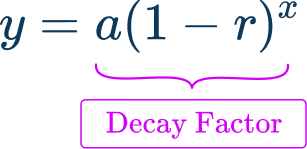
The decay factor is the number that shows how much an amount decreases over time. Since the equation models a decay, the answer must be less than the initial amount.
For example, a new car originally costs \$ 20,000. The car’s value has an annual depreciation rate (exponential decay rate) of 10 \%. Using the exponential decay formula, find the value of the car after 6 years.
y=a(1-r)^x \begin{aligned}a&=\text { initial amount which is } \$ 20,000 \\\\ x&=\text { time which in this case is } 6 \text { years } \\\\ r&=\text { percent of decay which in this case is }10 \% \end{aligned}Remember, you must change a percent to a decimal or fraction before doing a calculation.
10 \%=0.10See also: Converting percents to decimals
y=20,000(1-0.10)^6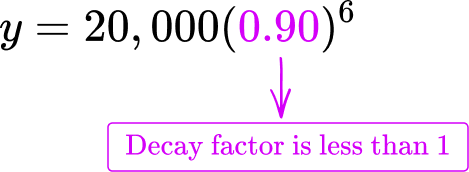
With a depreciation rate of 10 \%, after 6 years the car will be worth \$ 10,628.82
![[FREE] Percents Check for Understanding (Grade 6 to 7)](https://thirdspacelearning.com/wp-content/uploads/2023/07/Percents-check-for-understanding-quiz-listing-image-.png)
[FREE] Percents Check for Understanding (Grade 6 to 7)
![[FREE] Percents Check for Understanding (Grade 6 to 7)](https://thirdspacelearning.com/wp-content/uploads/2023/07/Percents-check-for-understanding-quiz-listing-image-.png)
Use this quiz to check your grade 6 to 7 students’ understanding of percents. 10+ questions with answers covering a range of 6th and 7th grade percent topics to identify areas of strength and support!
DOWNLOAD FREE![[FREE] Percents Check for Understanding (Grade 6 to 7)](https://thirdspacelearning.com/wp-content/uploads/2023/07/Percents-check-for-understanding-quiz-listing-image-.png)
[FREE] Percents Check for Understanding (Grade 6 to 7)
![[FREE] Percents Check for Understanding (Grade 6 to 7)](https://thirdspacelearning.com/wp-content/uploads/2023/07/Percents-check-for-understanding-quiz-listing-image-.png)
Use this quiz to check your grade 6 to 7 students’ understanding of percents. 10+ questions with answers covering a range of 6th and 7th grade percent topics to identify areas of strength and support!
DOWNLOAD FREEExponential graph
Exponential decay functions can be modeled on the coordinate plane.
For example, the function, y=1\left(\cfrac{1}{2}\right)^x can be sketched on the coordinate plane using a table of values.
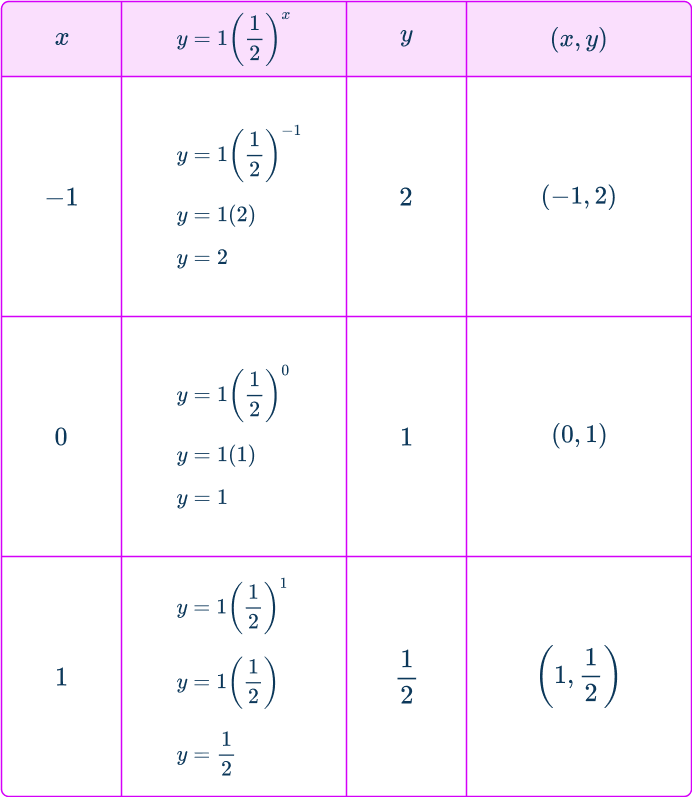
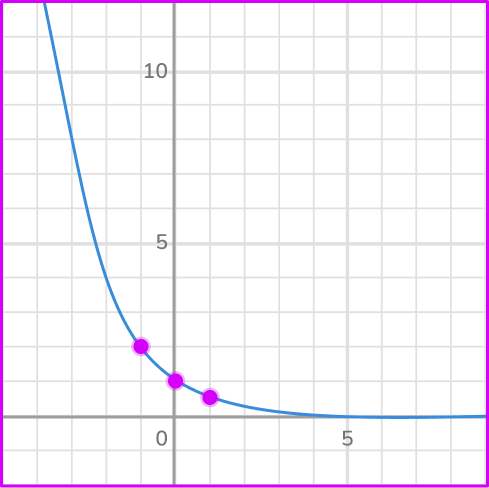
Notice how the curve of the exponential decay function curves down towards the x -axis but does not cross the x -axis. This is because the x -axis is the horizontal asymptote of the function.
See also: Exponential functions
What is exponential decay?
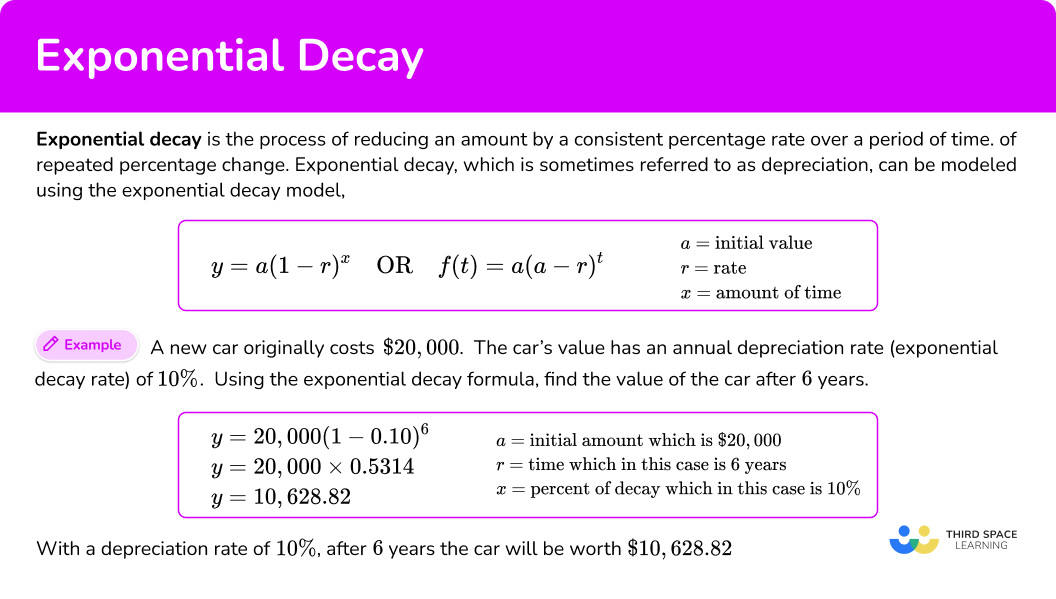
Common Core State Standards
How does this apply to middle school and high school math?
- 7th Grade – Ratios and Proportional Relationships (7.RP.A.3)
Use proportional relationships to solve multistep ratio and percent problems. Examples: simple interest, tax, markups and markdowns, gratuities and commissions, fees, percent increase and decrease, percent error.
- High School Algebra – Seeing Structure in Expressions (HSA.SSE.B.3c)
Use the properties of exponents to transform expressions for exponential functions. For example, the expression 1.15t can be rewritten as (1.151/12)12t \approx 1.01212t to reveal the approximate equivalent monthly interest rate if the annual rate is 15 \%.
- High School Functions – Linear, Quadratic and Exponential Models (HSF-LE.A.1c)
Recognize situations in which a quantity grows or decays by a constant percent rate per unit interval relative to another.
How to calculate exponential decay
In order to calculate an exponential decay:
- Identify the values that are given.
- Calculate the exponential decay.
- State the solution.
Exponential decay examples
Example 1: finding a value after a depreciation
A boat is bought for \$ 30,000. It depreciates at a rate of 5 \% per year. Find its value after 3 years.
- Identify the values of the model that are given.
Using the exponential decay equation,
y=a(1-r)^xThe initial value is the price of the boat, \$ 30,000, so, a=30,000 .
The time is 3 years, so x=3 .
The rate of decay is 5 \%, so r=5 \%=0.05 .
2Use the model to calculate the decay.
The model, y=a(1-r)^x calculates the value of the decay.
In this case, substitute the values into the equation and solve for y.
\begin{aligned}& y=30,000(1-0.05)^3 \\\\ & y=30,000(0.95)^3 \\\\ & y=25,721.25 \end{aligned}3State the solution.
After 3 years, the value of the boat will be \$ 25,721.25.
Example 2: predicting population
In 2019 , the population of wolves in a certain area of Montana was 820. Due to the environment, the wolf population is declining. If the rate at which the population is declining is 4 \% per year. Approximately, what will the population of wolves be in 2025 ?
Identify the values that are given.
The initial population of wolves is 820, so a=820 .
From 2019 to 2025 is 6 years, so x=6 .
The rate is 4 \% which is 0.04 as a decimal, so r=0.04 .
Calculate the exponential decay.
Using the model, y=a(1-r)^x , substitute the values into the equation.
\begin{aligned}& y=820(1-0.04)^6 \\\\
& y=820(0.96)^6 \\\\
& y \approx 641.86 \end{aligned}
State the solution.
Since y=641.86, the approximate population of wolves in 2025 will be about 642.
Example 3: investment
Jill makes an initial investment of \$ 10,000. The investment loses 8.5 \% interest per year. How much money does Jill have at the end of 4 years?
Identify the values that are given.
The initial amount is \$ 10,000, so a=10,000 .
The rate is 8.5 \% which is 0.85, so r=0.085 .
The time is 4 years, so x=4 .
Calculate the exponential decay.
Using the model, y=a(1-r)x , substitute the values into the equation.
\begin{aligned}& y=10,000(1-0.085)^4 \\\\
& y=10,000(0.915)^4 \\\\
& y=7009.46 \end{aligned}
State the solution.
After 3 years, Jill will have \$ 7009.46 in her account.
How to determine the rate of decay
In order to identify the rate of decay:
- Identify the decay factor.
- Subtract the decay factor from \bf{1}.
- Change the number into a percent.
- State the percent.
Example 4: rate of decay
The exponential model, y=100(0.5)^x represents bacteria population over a period of time. What is the decay rate?
Identify the decay factor.
The decay factor is the decimal number in the parenthesis being raised to the x power. In this case the value is 0.5.
Subtract the decay factor from \bf{1}.
Change the number into a percent.
Multiply the number by 100 to change it to a percent.
0.5 \times 100=50
State the percent.
The percent of decay is 50 \%.
Example 5: percent of decay
The function, f(x)=16000\left(\cfrac{1}{3}\right)^x represents an exponential decay. What is the percent of decay?
Identify the decay factor.
In this case, the decay factor is the number in the parenthesis being raised to the x power which is \cfrac{1}{3}.
Subtract the decay factor from \bf{1}.
Change the number into a percent.
To convert the fraction to a percent, first change the fraction to a decimal. You can do this by dividing the denominator into the numerator.
\cfrac{2}{3}=0.666667
Then multiply the decimal to 100.
0.6666667 \times 100=66.67 \%
Another strategy you could use is to make a proportion,
\begin{aligned} \cfrac{2}{3}&=\cfrac{x}{100} \\\\ 200&=3 x \\\\ 66.67&=x \\\\ 66.67 &\% \end{aligned}
State the percent.
The percent of decay is about 66.7 \%.
Step-by-step guide: Fraction to percent
Example 6
The function, y=290(0.73)^x , represents an exponential decay. What is the percent of decay?
Identify the decay factor.
In this case, the decay factor is 0.73.
Subtract the decay factor from \bf{1}.
Change the number into a percent.
In order to change a decimal number to a percent, multiply the number by 100.
0.27 \times 100=27 \%
State the percent.
The percent of decay is 27 \%.
Teaching tips for exponential decay
- Make connections by comparing and contrasting exponential growth functions with exponential decay functions as well as connecting them to real life.
- Incorporate real world and cross disciplinary word problems such as half-life and radioactive decay.
- Use active learning activities such as scavenger hunts or game playing to have students review skills instead of giving them a worksheet.
- Encourage students who are struggling to use digital platforms such as Khan Academy so they can view tutorial videos.
Easy mistakes to make
- Using the decay rate without subtraction from \bf{1}
For example, when the decay rate is 15 \%, using 0.15 as the decay factor instead of subtracting it from 1.
When the decay rate is 15 \%, you first have to convert that to a decimal number, 0.15, and then subtract it from 1. So in this case, the decay factor to use is 1-0.15=0.85.
0.85 is the decay factor.
- Forgetting to convert percents to decimals before performing calculations
For example, if the decay rate is 13 \% , using 13 instead of 0.13 to make the calculations.
Practice exponential decay questions
1. What is the decay factor when the percent of decay is 4 \%?




To find the decay factor, you have to subtract the percent of decay from 1. However, before doing that, you have to convert percent to a decimal.
4 \%=0.04 (divide 4 by 100)
Next, subtract 0.04 from 1.
1-0.04=0.96
The decay factor is 0.96.
2. What is the decay factor that should be used for a decay rate of 27 \%?




To find the decay factor, you have to subtract the percent of decay from 1. However, before doing that, you have to convert percent to a decimal.
27 \%=0.27 (divide 27 by 100)
Then, subtract 0.27 from 1.
1-0.27=0.73
0.73 is the decay factor.
3. A car is bought for \$ 12 000 and depreciates at a rate of 8 \% per year. Find its value after 3 years.




To calculate the value of the car, use y=a(1-r)^x , where:
\begin{aligned}& a=\text { initial amount } \\\\ & r=\text { percent } \\\\ & x=\text { time } \end{aligned}
In this case,
\begin{aligned}& a=12,000 \\\\ & r=8 \%=0.08 \\\\ & x=3 \end{aligned}
Substitute the values into the equation,
\begin{aligned}& y=12,000(1-0.08)^3 \\\\ & y=12,000(0.92)^3 \\\\ & y=9344.256 \approx 9344.26 \end{aligned}
The value of the car after 3 years will be \$ 9344.26
4. The population of a southwest town in 2024 is 25,670. The town’s population is decreasing by a rate of 3.5 \% per year. What will be the town’s approximate population in the year 2030?




To calculate the population, use the model, y=a(1-r)^x where,
\begin{aligned}& a=\text { initial amount } \\\\ & r=\text { percent } \\\\ & x=\text { time } \end{aligned}
In this case,
\begin{aligned}& a=25,670 \\\\ & r=3.5 \%=0.035 \\\\ & x=6(2030-2024=6) \end{aligned}
Substitute the values into the equation to calculate.
\begin{aligned}& y=25670(1-0.035)^6 \\\\ & y=25670(0.965)^6 \\\\ & y=20729.5 \approx 20730 \end{aligned}
5. The function, y=119(0.43)^x , represents an exponential decay. What is the percent of decay?




The decay factor in this case is 0.43. Subtract that value from 1 and then change the decimal answer to a percent.
\begin{aligned}& 1-0.43=0.57 \\\\ & 0.57 \times 100=57 \end{aligned}
The percent of decay is 57 \% .
6. The function, f(x)=236\left(\cfrac{3}{4}\right)^x represents an exponential decay. What is the percent of decay?




The decay factor in this case is \cfrac{3}{4}. Subtract that value from 1 and then change the fraction answer to a percent.
1-\cfrac{3}{4}=\cfrac{1}{4}
\begin{aligned}& \cfrac{1}{4}=0.25 \\\\ & 0.25 \times 100=25 \end{aligned}
The percent of decay is 25 \%.
Exponential Decay FAQs
The growth factor is similar to the decay factor. It’s the number that shows how much an amount increases over time as opposed to how much a number decreases over time.
The growth rate is similar to the decay rate, it’s the percent of how fast a value of a function is increasing instead of decreasing like the decay rate.
In an Algebra 2 class, you study polynomial functions, logarithm functions, exponential functions. quadratic functions, and linear functions.
The inverse of an exponential function is a logarithm function.
No, differential equations can be used to represent growth and decay.
For example, \cfrac{dy}{dt}=ky is a differential equation representing growth and decay where time \cfrac{dy}{dt} is the rate of change (time t ) and , k the constant of the proportion.
The next lessons are
- Compound measures
- Types of data
- Averages and ranges
Still stuck?
At Third Space Learning, we specialize in helping teachers and school leaders to provide personalized math support for more of their students through high-quality, online one-on-one math tutoring delivered by subject experts.
Each week, our tutors support thousands of students who are at risk of not meeting their grade-level expectations, and help accelerate their progress and boost their confidence.

Find out how we can help your students achieve success with our math tutoring programs.
[FREE] Common Core Practice Tests (3rd to 8th Grade)
Prepare for math tests in your state with these 3rd Grade to 8th Grade practice assessments for Common Core and state equivalents.
Get your 6 multiple choice practice tests with detailed answers to support test prep, created by US math teachers for US math teachers!